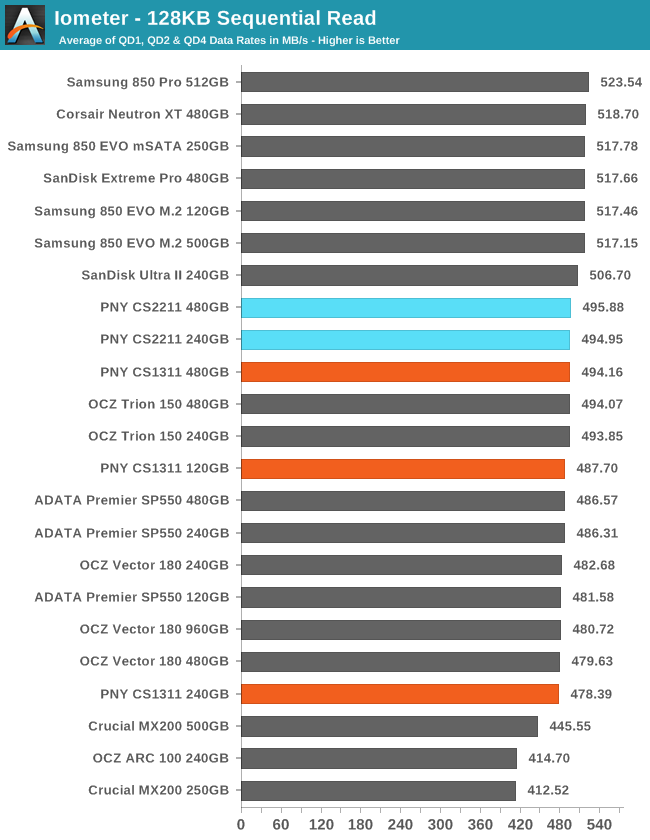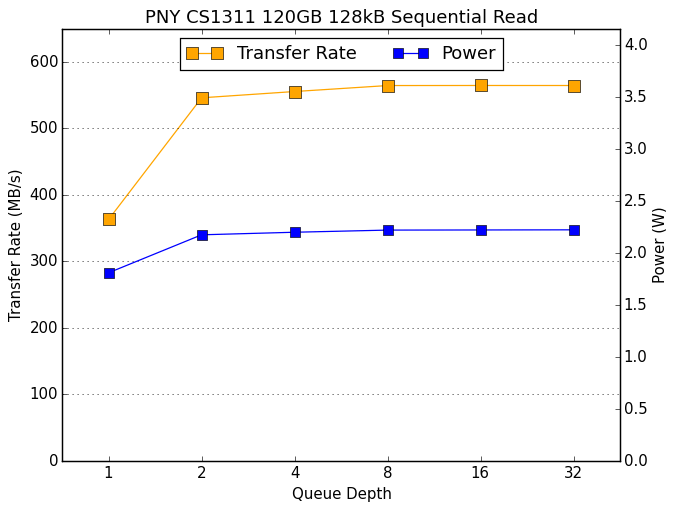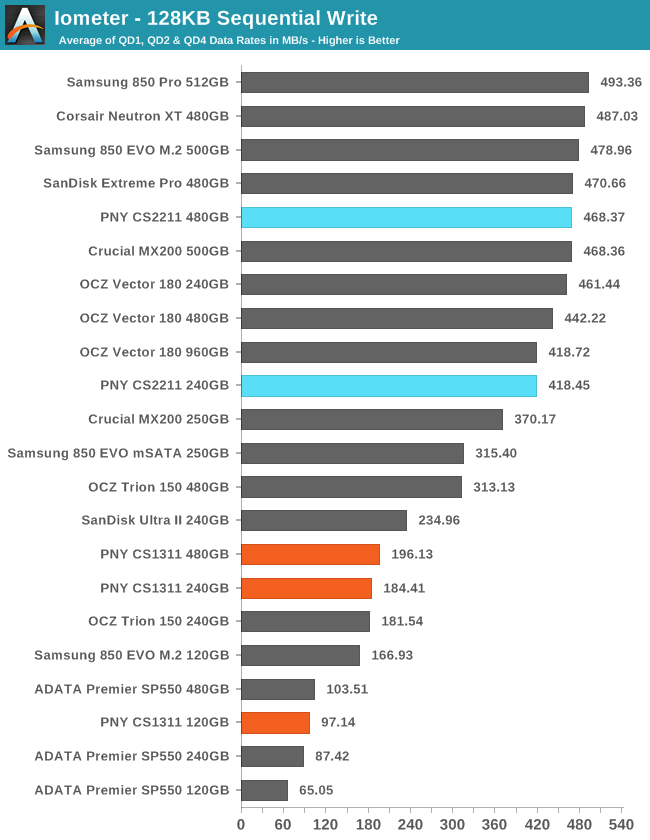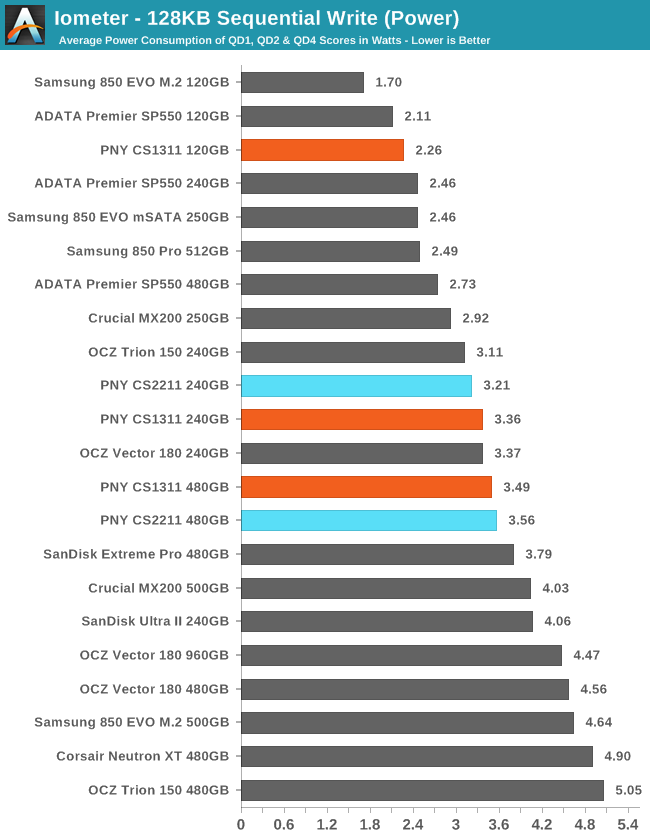The PNY CS1311 and CS2211 SSD Review: MLC vs TLC at 15nm
by Billy Tallis on April 15, 2016 8:00 AM ESTSequential Read Performance
The sequential read test requests 128kB blocks and tests queue depths ranging from 1 to 32. The queue depth is doubled every three minutes, for a total test duration of 18 minutes. The test spans the entire drive, and the drive is filled before the test begins. The primary score we report is an average of performances at queue depths 1, 2 and 4, as client usage typically consists mostly of low queue depth operations.

The sequential read performance of the PNY drives puts them all in the second tier of drives with lots of close competition and nothing to complain about. Choice of flash makes little difference to this benchmark: basically everything can saturate the SATA connection by QD4, so the differences here mostly reflect QD1 performance.

The power consumption shows that the MLC drives are a bit less power-hungry than the TLC drive of the same size (and therefore also more efficient, since the MLC drives are also faster), and that the larger drives are unsurprisingly more power-hungry.
 |
|||||||||
The CS2211 and the largest CS1311 hit full speed at QD2, but the smaller two TLC drives still have a little to gain from QD2 to QD8. Power consumption on all the PNY drives is flat starting at QD2.
Sequential Write Performance
The sequential write test writes 128kB blocks and tests queue depths ranging from 1 to 32. The queue depth is doubled every three minutes, for a total test duration of 18 minutes. The test spans the entire drive, and the drive is filled before the test begins. The primary score we report is an average of performances at queue depths 1, 2 and 4, as client usage typically consists mostly of low queue depth operations.

The sequential write test clearly shows the write performance advantage of TLC over MLC, and the advantage of increased parallelism in larger drives. It's interesting that the 480GB CS1311 has such a small advantage over the 240GB despite having the advantage of an 8-channel controller, while the 120GB CS1311 is clearly starved for parallelism.

Power consumption during the sequential write test is strongly correlated with drive capacity, showing once again that the higher efficiency of MLC is offset by the higher throughput.
 |
|||||||||
The CS1311 actually drops slightly in performance from QD1 to QD2, but is stable after that. The CS2211 gains significantly from QD1 to QD2 and but scales no further.










43 Comments
View All Comments
Ascaris - Friday, April 29, 2016 - link
My PNY 760 is still going strong too. No plans to replace it at present, as it still does what I need.StrangerGuy - Friday, April 15, 2016 - link
I know this is an SSD, but...PC industry: "Hey, let's continue to make gaudy looking hardware to appeal to the xtremez hardcorez teenage gamerz crowd instead of adult gamers with actual disposable income."
deeksha - Saturday, April 16, 2016 - link
yours idea is really good and innovative , these resources are really awesome thanks for sharing those information and i got more in formation about this concept.
watzupken - Saturday, April 16, 2016 - link
I have to agree that at the mid/low range, currently the Samsung 850 Evo seems like the best buy in terms of performance and endurance. Still I wonder why so many manufacturers are jumping in and piling up with budget SSDs.hlmcompany - Tuesday, April 19, 2016 - link
They want a piece of the pie. They figure that with their brand on a popular item, they will be able to reap some profit. Over the years, my best selling SSD's have been Intel and Samsung. Lately, I've been impressed with SanDisk and have included them to my lineup.hlmcompany - Monday, April 18, 2016 - link
The SanDisk X400 512GB SATA SSD at $122.00 from Amazon USA is also a good option.slowdemon21 - Thursday, April 28, 2016 - link
you guys are so two-faced, the #1 complaint of SSD is too expensive, so a new lower cost SSD appears and your answers are, i.e. "not worth it...pay a little more for better" LOL bi-polar much?Ascaris - Friday, April 29, 2016 - link
Do you know for sure it's the same people making those comments? It's not hard to imagine that one site could have readers of both types commenting.slowdemon21 - Thursday, April 28, 2016 - link
one more thing...if your looking for 3 or SSD's, the extra $$ adds up. e.g. a desktop, laptop. PS4...maybe a 2 year old laptop. Bingo! four already... [talking real world]slowdemon21 - Thursday, April 28, 2016 - link
OCZ TRION 150 BENCHED IN THE MIDDLE OF MOST OF THESE TEST, there's the Winner